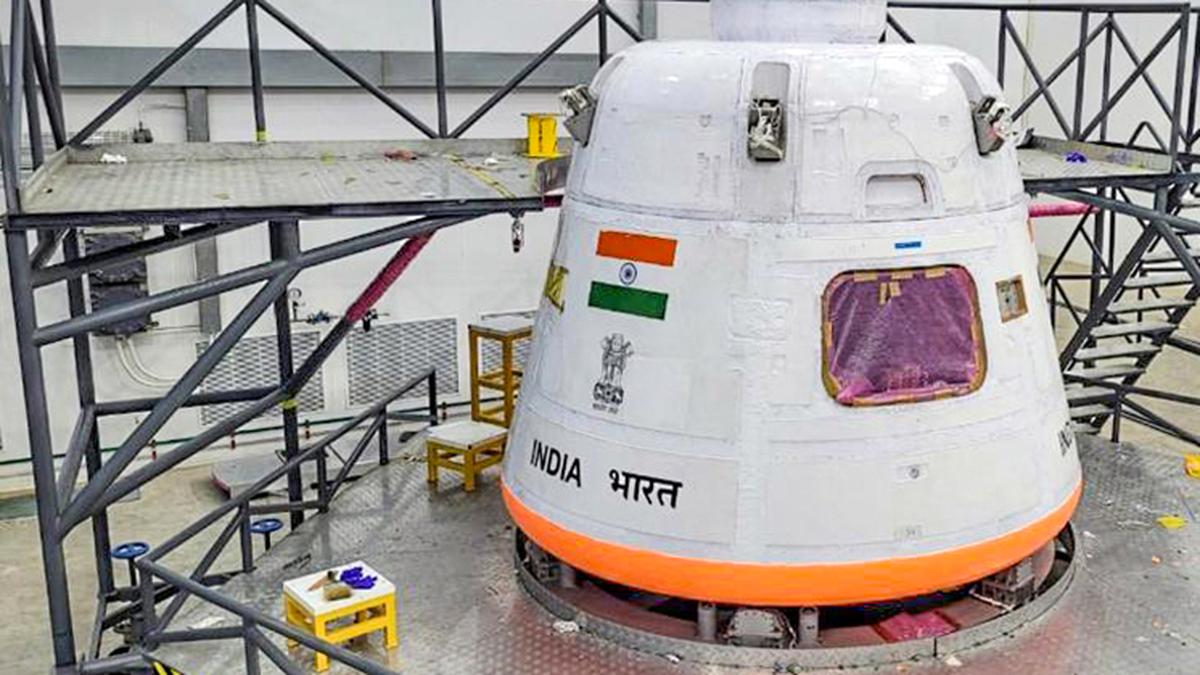ISRO preparing to commence unmanned flight tests for the Gaganyaan Mission, in Sriharikota in 2023.
| Photo Credit: ANI
The story so far: The Gaganyaan mission aims to safely transport Indian astronauts to a low-earth orbit of around 400 km altitude using the human-rated LVM3 (HLVM3) rocket as the launch vehicle, and to return them safely. In human space missions, crew safety is more important than mission success. It is imperative that safety is addressed during all phases: launch pad, ascent, orbit, and descent.
What is the CES?
A dedicated Crew Escape System (CES) will be used during the initial part of the atmospheric phase of the Gaganyaan mission to ensure crew safety in the event of a contingency that jeopardises the mission. The CES is designed to rapidly separate the crew module, along with the crew, from a malfunctioning launch vehicle, and move it to a safe distance in the least possible time. The atmospheric phase of flight is one of the most critical stages of the ascent, during which the rocket accelerates to hypersonic speeds — more than five times the speed of sound — and will be experiencing very high structural loads. The HLVM3 rocket is equipped with two powerful S200 solid-fuel boosters to lift off, and unlike liquid or cryogenic engines, solid motors cannot be shut down once they are ignited. Thus, the CES must extract the crew module with greater acceleration than the launch vehicle itself, and in minimal time. The CES is a quick-acting system positioned at the forward end of the launch vehicle and is equipped with multiple special-purpose solid motors. These motors use high burn-rate propellants that consume fuel faster than conventional solid motors, generating higher acceleration.
In the Gaganyaan mission, the CES could impart acceleration up to 10-times that of gravity. For a healthy human body, such high acceleration is tolerable for a few seconds if the crew is positioned correctly, with the acceleration acting perpendicular to the chest and the body pressed against the seat in a “child in cradle” orientation. Rocket systems are more intricate than those of aircraft, with rocket reliability much lower than that of passenger aircraft. Nevertheless, the CES significantly improves crew survival probability through its heritage-based design, redundant systems, and robust mission planning.
What are different types?
The CES is classified into two types based on the way it extracts the crew module: (i) puller type — used in Gaganyaan, where the CES pulls the crew module away from the launch vehicle; (ii) pusher type — used in vehicles like SpaceX’s Falcon 9, where the crew module is pushed away using compact, high-thrust liquid-fuel engines. Both systems have advantages and disadvantages, with the choice depending on propulsion technology and system integration aspects. The U.S.’s Saturn V, Russia’s Soyuz, and China’s Long March vehicles also use puller-type CES designs.
In September, 1983, two Soviet cosmonauts escaped a massive explosion on the launchpad when their Soyuz rocket caught fire just before lift-off. Their lives were saved by the launch vehicle’s automatic crew escape system. This remains the first and only time a crewed launch escape system was activated before lift-off.
Once the CES has moved the crew module a safe distance away from the failing vehicle, the module will be released and decelerated by a multistage parachute system. This will reduce the module’s velocity in steps, ensuring it splashes down safely in the sea without exceeding the crew’s physiological limits upon impact. Typically, the crew will remain inside the module until splashdown. But during the Soviet Union’s first human spaceflight, Yuri Gagarin ejected from the Vostok module at approximately 7 km altitude and parachuted safely to the ground.
The Integrated Vehicle Health Management system (IVHM), which is a network of sensors, electronics, and software, will aid in taking a decision to activate the CES when a contingency arises. It will monitor all vital parameters of vehicle systems and crew health in real time. Based on the synthesised information and the flight regime, it will ensure prompt anomaly detection, minimise false alarms, and activate the CES early enough to protect the crew.
Has it been tested?
The ISRO has developed a cost-effective, single-stage Test vehicle powered by the Vikas engine to validate the CES. The first successful test occurred in October 2023, during which the CES was activated when the Test vehicle reached transonic conditions — a critical phase in atmospheric flight when the velocity transitions from subsonic to supersonic. ISRO plans additional Test vehicle flights to simulate other critical ascent trajectory conditions. The CES is a cornerstone of the Gaganyaan programme and reflects ISRO’s commitment to astronaut safety. By integrating advanced engineering, rigorous testing, and reliable systems like the IVHM, the CES ensures India’s first human spaceflight mission will prioritise the safe return of its crew, even in the face of unforeseen challenges.
Unnikrishnan Nair S. is former director, VSSC; Founding Director, HSFC; and an expert in orbital reentry and human spaceflight technologies.
Published – October 15, 2025 08:30 am IST
